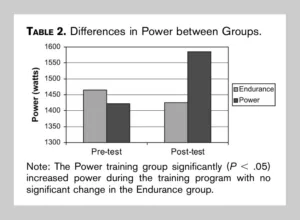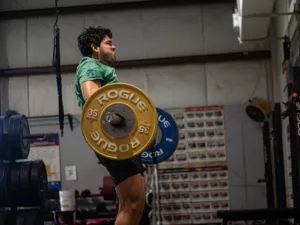 Within the baseball world, the age-old debate rages on: Should pitchers run long distances to improve their pitching stamina? Many pitchers feel that increasing their endurance by distance running will improve their performance on the mound, but new scientific research shows otherwise. This article will delve further into the adaptations your body undergoes when you engage in various forms of training, with a focus on why long-distance running may not be the greatest option for baseball pitchers. With insights from the TopVelocity programs, we'll look at why strength training could be the secret sauce to taking your game to the next level.
Within the baseball world, the age-old debate rages on: Should pitchers run long distances to improve their pitching stamina? Many pitchers feel that increasing their endurance by distance running will improve their performance on the mound, but new scientific research shows otherwise. This article will delve further into the adaptations your body undergoes when you engage in various forms of training, with a focus on why long-distance running may not be the greatest option for baseball pitchers. With insights from the TopVelocity programs, we'll look at why strength training could be the secret sauce to taking your game to the next level.
Exercise Adaptation in the Body: Should Pitchers Run Long Distance?
When we exercise, our bodies change in order to adapt to the specific demands of the activity. Pitchers Run Long Distances, for example, trains their body to increase endurance and stamina while conserving calories. However, it does not necessitate a significant amount of muscle mass. The body is intelligent and adapts well, learning how to function on less calories consumed and calories burned during activity.
What does this adaptation signify in the context of baseball, particularly for pitchers? While endurance and stamina are crucial, they are not the only or even the most important aspects of pitching success. Muscle and power development are both essential. Distance running can actually cause muscle loss and impair the body's capacity to produce the muscle power required for elite-level throwing.
The Argument Against Endurance Training: Should Pitchers Run Long Distance?
 A recent study sheds fresh light on the detrimental effects of moderate- to high-intensity cardiovascular endurance exercise on lower body power (Rhea et al., 2008). This is especially important for baseball pitchers, whose effectiveness is strongly dependent on power tasks such as running, throwing, and jumping. The study was one of the first to indicate that combining endurance training, from running long distances, with high-intensity muscular power training actually reduced power in baseball players.
A recent study sheds fresh light on the detrimental effects of moderate- to high-intensity cardiovascular endurance exercise on lower body power (Rhea et al., 2008). This is especially important for baseball pitchers, whose effectiveness is strongly dependent on power tasks such as running, throwing, and jumping. The study was one of the first to indicate that combining endurance training, from running long distances, with high-intensity muscular power training actually reduced power in baseball players.
Notably, the study discovered a significant variance in how individuals' bodies responded to the various training methods. Except for three individuals in the endurance (END) training group, all experienced a decrease in power ranging from 17 to 299 watts. Meanwhile, everyone in the strength power training (SPT) group increased their power by 5 to 535 watts. This apparent disparity suggests that strength power training has advantages for building the specific muscle groups and neurological systems required for peak baseball pitching ability.
The Incompatibility Science
The study dives deeper into the physiological and neurological causes of these findings. When Pitchers Run Long Distance, activation of AMP-activated protein kinase (AMPK) and inhibition of eEF2 kinase (eEF2K) might hamper the body's anabolic response to resistance training, stifling the growth of muscular power. Furthermore, endurance training may impair crucial neurological adaptations required for power growth, such as muscle fiber recruitment and synchronization.
The Influence of Strength Training: Should Pitchers Run Long Distance?
When it comes to strength training, your body's response is different and possibly more useful for baseball pitchers. Strength training, as opposed to distance running, which typically results in a plateau after an initial weight loss, consistently pushes your body to grow muscle. The increased muscle aids your body's ability to burn calories more efficiently and generate more power.
The Impact of Body Composition on Peak Force and Anaerobic Power
 Pearson et al. (2019) from the University of Tampa conducted an intriguing study to investigate the association between body composition and performance indicators such as peak force and anaerobic power in Division II collegiate baseball players. The study was conducted retrospectively and investigated four years of body composition data as well as performance assessments for 95 participants. A DEXA scan was performed on each subject, as well as a countermovement vertical jump (CMJ) or a Wingate test (WIN).
Pearson et al. (2019) from the University of Tampa conducted an intriguing study to investigate the association between body composition and performance indicators such as peak force and anaerobic power in Division II collegiate baseball players. The study was conducted retrospectively and investigated four years of body composition data as well as performance assessments for 95 participants. A DEXA scan was performed on each subject, as well as a countermovement vertical jump (CMJ) or a Wingate test (WIN).
Important Findings
- Total Lean Body Mass (TLBM): During the Wingate test, TLBM was found to be substantially linked with anaerobic power. The association with countermovement jump peak force (CMJPF) was, however, only moderate.
- Lower Body Lean Mass (LBLM): Like TLBM, LBLM correlated strongly with the Wingate test but very moderately with CMJPF.
- Body Fat Percentage (BF): Surprisingly, on the Wingate test, body fat percentage had only a weak connection with anaerobic power and no significant correlation with CMJPF.
- Bone Mineral Content (BMC): BMC was shown to be substantially associated with both the Wingate test and the CMJPF, showing that greater bone mass improves anaerobic power.
Training Program Implications
This research is extremely relevant to programs such as TopVelocity's 2X Position Player and 3X Pitching, where knowing the body's potential and limitations can have a direct impact on training approaches and outcomes. The findings strongly support the role of lean muscle mass in improving anaerobic power, which is an important part of a pitcher's effectiveness.
Coaches' Practical Takeaways
 For best player performance, the findings imply that coaches should concentrate on muscle mass development, particularly during the off-season. Surprisingly, body fat did not appear to have a negative impact on performance, allowing for greater flexibility in conditioning programs. Because of the moderate link between TLBM and CMJPF, athletes may need to focus on additional modalities that promote tendon strength and elasticity via the stretch-shortening cycle.
For best player performance, the findings imply that coaches should concentrate on muscle mass development, particularly during the off-season. Surprisingly, body fat did not appear to have a negative impact on performance, allowing for greater flexibility in conditioning programs. Because of the moderate link between TLBM and CMJPF, athletes may need to focus on additional modalities that promote tendon strength and elasticity via the stretch-shortening cycle.
Future Research Initiatives
Given the significant positive association between lean body mass and anaerobic power, it's critical to look at how body composition changes over time affect performance. This will aid in the refinement of player development programs to match the unique needs of individual athletes, which is a fundamental goal of TopVelocity's science-backed training.
Understanding the subtleties of how body composition influences performance measures can have a big impact on a player's training and on-field performance. The outcomes of this study highlight the role of lean muscle mass in improving anaerobic power and provide significant insights for future training programs. TopVelocity's commitment to evidence-based practice guarantees that athletes are getting the most out of their training, laying the groundwork for greater levels of achievement.
TopVelocity's 3X Velocity Camp can help you improve your game
 The Influence of Science-Based Training
The Influence of Science-Based Training
Optimizing body composition factors can dramatically improve your anaerobic power and overall performance in the field, as proven by the cutting-edge research given in this article. Baseball players can no longer afford to overlook the role of evidence-based training as the game becomes more competitive and scientific in its approach. That's where TopVelocity's 3X Velocity Camp comes in.- What exactly is the 3X Velocity Camp?
TopVelocity's 3X Velocity Camp is a customized program designed to help pitchers raise their throwing velocity while lowering their risk of injury. The approach utilizes cutting-edge science, such as the insights described in this article, to give a holistic training regimen that tackles strength, biomechanics, and mental readiness.
Why Should You Attend the 3X Velocity Camp?
- Evidence-Based Training: The training approaches used by the program are based on scientific principles and current research.
- Individual Attention: Each athlete receives a biomechanical study, which aids in tailoring the program to their specific demands.
- Injury Prevention: The camp's emphasis on biomechanical efficiency not only improves performance but also reduces the chance of injury, which is crucial for career longevity.
Don't pass up the chance to take your game to the next level. TopVelocity's 3X Velocity Camp is the secret to unlocking your full potential in an era where minor gains can mean the difference between mediocre and outstanding.
Secure your spot today and transform your baseball career with scientifically proven training that guarantees verifiable results.
TopVelocity's 3X Velocity Camp has more information and registration.
Let's make this your finest season yet. Join us as we apply science to player development and performance advancement. Baseball's future begins with you, and it begins right now at TopVelocity's 3X Velocity Camp.
For more exclusive content, remote coaching, and weekly video analysis check out the TopVelocity Patreon!
FAQs: Should Pitchers Run Long Distance?
Q: How does endurance training affect a pitcher's performance?
A: Endurance training, particularly at high levels, can have a negative impact on a pitcher's overall effectiveness. This is substantiated by scientific studies that show that adding rigorous cardiovascular exercise may limit the power required for crucial actions such as running, throwing, and jumping.
Q: Could you perhaps explain on the physiological mechanisms that lead to this power decline?
A: Of course. When you exercise endurance, your body activates particular biochemical and neurological processes. These circuits frequently favor endurance and stamina over force. Endurance exercise, for example, increases AMPK while suppressing eEF2 kinase (eEF2K), which can impede the anabolic response required for power and strength training. Furthermore, neural changes important for power growth, such as muscle fiber recruitment and synchronization, can be harmed.
Q: How are TopVelocity programs addressing these issues?
A: TopVelocity programs, such as our flagship 3X Pitching program, are painstakingly developed to target the essential muscle groups and neurological systems used by pitchers during games. We prioritize strength and power training over high-intensity endurance training to ensure you're adjusting in ways that benefit your pitching effectiveness. These programs attempt to improve your inherent abilities while also dramatically lowering your chance of harm.
Q: What scientific support does TopVelocity have?
A: Our programs are based on cutting-edge kinesiology and sports science research. According to case studies, participants in our programs see considerable increases in lower body power, which is essential for pitching effectiveness. We are constantly updating our programs to reflect the most recent research findings.
Q: Is the 3X Velocity Camp a decent place to start for people who are new to TopVelocity programs?
A: Without a doubt! The 3X Velocity Camp is a hands-on, intensive event in which you will master the principles of the 3X Pitching curriculum. It is intended for players of all levels who are serious about increasing their pitching performance and lowering their risk of injury.
Reference: Should Pitchers Run Long Distance?
Pearson, J., Wadhi, T., Rauch, J. T., Thiel, J., Andersen, J. C., O'Sullivan, J., & De Souza, E. O. (2019). The relationship between body composition with peak force and anaerobic power in collegiate baseball players. Medicine And Science In Sports And Exercise, 51(6), 913-913.
Rhea, M. R., Oliverson, J. R., Marshall, G., Peterson, M. D., Kenn, J. G., & Ayllón, F. N. (2008). Noncompatibility of power and endurance training among college baseball players. The Journal of Strength & Conditioning Research, 22(1), 230-234.


 The Influence of Science-Based Training
The Influence of Science-Based Training